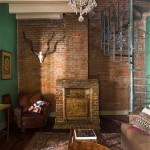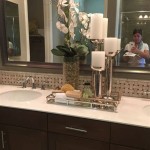How to Decorate Around Black Bedroom Furniture
Black bedroom furniture exudes sophistication and can create a dramatic focal point in any sleeping space. However, decorating effectively around black furniture requires careful consideration of various elements, including color palettes, textures, lighting, and accessories. If not approached thoughtfully, a room with black furniture can easily feel oppressive or stark. The objective is to strike a balance, creating a space that is both visually appealing and conducive to rest and relaxation. This article outlines key principles and strategies for decorating a bedroom that features black furniture, ensuring a harmonious and stylish aesthetic.
Understanding the Impact of Black
Black is a powerful and versatile color, but its impact in a bedroom should be carefully managed. It absorbs light, making a room appear smaller and potentially darker. Therefore, mitigating this effect is crucial. This can be achieved through strategic use of lighter colors on walls, flooring, and bedding. The goal is to create a visual contrast that prevents the room from feeling enclosed or gloomy. Black also serves as a neutral backdrop, allowing other colors and textures to stand out. This characteristic can be leveraged to introduce pops of color through artwork, accessories, and textiles.
The style of the furniture itself also plays a significant role. Black furniture ranges from sleek and modern designs to ornate, traditional pieces. The decorative approach should complement the furniture's style. For instance, a minimalist bedroom with contemporary black furniture might benefit from a monochrome color scheme with subtle textures, while a more traditional bedroom could incorporate richer colors and patterns to soften the starkness of the black finish.
Color Palette Selection
Choosing the right color palette is paramount when decorating around black bedroom furniture. The colors used will dictate the overall mood and atmosphere of the room. While black can be paired with virtually any color, some combinations are more effective than others in creating a balanced and inviting space.
Neutrals: Pairing black with other neutrals, like white, gray, and beige, is a classic and safe option. This combination creates a sophisticated and timeless look. Using various shades of gray can add depth and dimension to the room, softening the contrast between the black furniture and the walls. White walls are a popular choice, providing a clean and bright backdrop that helps to minimize the darkness of the black furniture. However, a warm-toned white or off-white can prevent the room from feeling sterile or clinical. Beige and other warm neutrals can also be used to create a cozy and inviting atmosphere, especially when paired with textured fabrics and natural materials.
Bold Colors: For those seeking a more dramatic and vibrant look, bold colors like red, gold, emerald green, or royal blue can be incorporated as accent colors. When using bold colors, it is important to exercise restraint and avoid overwhelming the space. Use these colors sparingly, focusing on accent pieces like throw pillows, artwork, lampshades, or a statement rug. Small pops of color can add personality and visual interest without overpowering the black furniture. For example, red cushions on a black bed or a vibrant painting on a white wall can create a striking focal point.
Pastels: Pastel colors can also work well with black furniture, creating a softer and more feminine aesthetic. Colors like blush pink, lavender, and pale blue can help to lighten the room and create a calming atmosphere. These colors are particularly effective when used in bedding, curtains, and wall decorations. The contrast between the dark furniture and the light, airy pastels can create a visually appealing and balanced space, preventing the room from feeling too heavy or dark.
Lighting Strategies
Effective lighting is crucial in a bedroom with black furniture. Since black absorbs light, it is essential to maximize both natural and artificial light sources. The strategic placement of lighting fixtures can significantly impact the mood and functionality of the room.
Natural Light: Maximize the use of natural light by keeping windows unobstructed. Use sheer curtains or blinds that allow sunlight to filter through while maintaining privacy. Mirrors can also be strategically placed to reflect natural light around the room, making it feel brighter and more spacious. Position mirrors opposite windows or near light sources to amplify the light and create a more open and airy atmosphere.
Ambient Lighting: Ambient lighting creates a soft, overall glow in the room. This can be achieved through the use of recessed lighting, chandeliers, or wall sconces. These fixtures should be positioned to evenly distribute light throughout the space, avoiding harsh shadows. Dimmable switches are beneficial, allowing for adjustments to the brightness level depending on the time of day and desired mood.
Task Lighting: Task lighting is specifically designed to provide focused illumination for activities such as reading or getting ready in the morning. Bedside lamps are essential for reading in bed, while a vanity mirror with integrated lighting is helpful for applying makeup or grooming. Consider the style of the task lighting fixtures and how they complement the black furniture and overall aesthetic of the room. Metal finishes like brass, gold, or silver can add a touch of elegance and sophistication.
Accent Lighting: Accent lighting is used to highlight specific features in the room, such as artwork, architectural details, or decorative accessories. Spotlights or track lighting can be used to draw attention to wall art, while small lamps or LED strips can be used to illuminate shelves or decorative objects. Accent lighting adds depth and visual interest to the room, creating a more layered and dynamic lighting scheme.
Textural Elements and Fabrics
Introducing a variety of textures is essential to prevent a bedroom with black furniture from feeling flat or monotonous. Different textures add depth, visual interest, and tactile appeal to the space. Fabrics, in particular, play a significant role in creating a comfortable and inviting atmosphere.
Bedding: Bedding is a primary source of texture in the bedroom. Consider using a mix of materials, such as linen, cotton, velvet, and faux fur, to create a layered and inviting bed. A textured duvet cover, soft throw blankets, and decorative pillows can add visual interest and provide a cozy feel. Avoid using overly smooth or shiny fabrics, as they can create a stark contrast with the black furniture. Instead, opt for materials with a natural or slightly rough texture to soften the look.
Rugs: A rug can anchor the room and add warmth and texture to the floor. Choose a rug with a plush pile or an interesting pattern to break up the monotony of the flooring. Wool, shag, and jute rugs are excellent options for adding tactile appeal. The color and pattern of the rug should complement the overall color scheme of the room. A light-colored rug can help to brighten the space and create a contrast with the black furniture, while a patterned rug can add visual interest and personality.
Curtains and Window Treatments: Curtains and window treatments provide an opportunity to add texture and visual softness to the room. Choose fabrics that complement the bedding and rug. Linen, velvet, and silk curtains can add a touch of luxury and sophistication. Layering curtains, such as using sheer curtains underneath heavier drapes, can create depth and visual interest. The color of the curtains should complement the overall color scheme of the room. Light-colored curtains can help to brighten the space, while patterned curtains can add personality and visual interest.
Wall Textures: Consider adding texture to the walls to create a more dynamic and interesting space. Textured wallpaper, such as grasscloth or embossed paper, can add depth and visual interest. Alternatively, consider using a textured paint technique or adding architectural details like wainscoting or trim. These elements can add character to the room and create a more layered and visually appealing space.
Accessories and Décor
Accessories and décor are essential for personalizing a bedroom and adding the finishing touches to the overall design. These elements can reflect the individual's style and create a cohesive and inviting space. When decorating around black furniture, it is important to choose accessories that complement the color palette, textures, and overall aesthetic of the room.
Artwork: Artwork is a powerful tool for adding personality and visual interest to a bedroom. Choose pieces that complement the color scheme and style of the room. Large-scale paintings or prints can serve as focal points, while smaller pieces can be used to create a gallery wall. Consider the frames used for the artwork. Metal frames, particularly gold or brass, can add a touch of elegance and sophistication, while wooden frames can create a more rustic or natural feel.
Mirrors: Mirrors are not only functional but also decorative. They can be used to reflect light around the room, making it feel brighter and more spacious. A large mirror placed opposite a window can significantly enhance the natural light in the room. Decorative mirrors with interesting frames can also serve as focal points. Consider the shape and style of the mirror to ensure that it complements the overall aesthetic of the room.
Plants and Greenery: Introducing plants and greenery into the bedroom can add a touch of nature and freshness to the space. Plants can help to purify the air and create a more relaxing and inviting atmosphere. Choose plants that thrive in indoor environments and require minimal maintenance. Potted plants, hanging plants, and floral arrangements can all be used to add visual interest and texture to the room. Consider the style of the planters and vases used to ensure that they complement the overall aesthetic of the room.
Decorative Objects: Decorative objects, such as vases, candles, sculptures, and books, can be used to add personality and visual interest to the room. Arrange these objects on shelves, nightstands, and dressers to create vignettes that reflect the individual's style and interests. Choose objects that complement the color palette and textures of the room. Metallic accents, such as gold or silver, can add a touch of elegance and sophistication. Avoid overcrowding the space with too many accessories, as this can create a cluttered and overwhelming look.
By following these guidelines, one can effectively decorate around black bedroom furniture, creating a space that is both stylish and comfortable. Careful consideration of color palettes, lighting strategies, textures, and accessories will result in a harmonious and visually appealing bedroom.

Black Furniture Trend And Easy Hit Decorations Home Improvement Trends Bedroom Design Set

Try Out Something Diffe Like Black Furniture For Your Indoors Stylish Bedro Bedroom Fresh Decor

Black Bedroom Design Ideas Cafe

Black Bedroom Ideas For A Dark And Cosy Sanctuary

Black Bedroom Design Ideas Cafe

Pin On Home Is Where The

51 Beautiful Black Bedrooms With S Tips Accessories To Help You Design Yours

Black Bedroom Ideas Furniture Gharexpert Com

15 Beautiful Black And White Bedroom Ideas Decor

75 Stylish Black Bedroom Ideas And Photos Shutterfly
Related Posts







